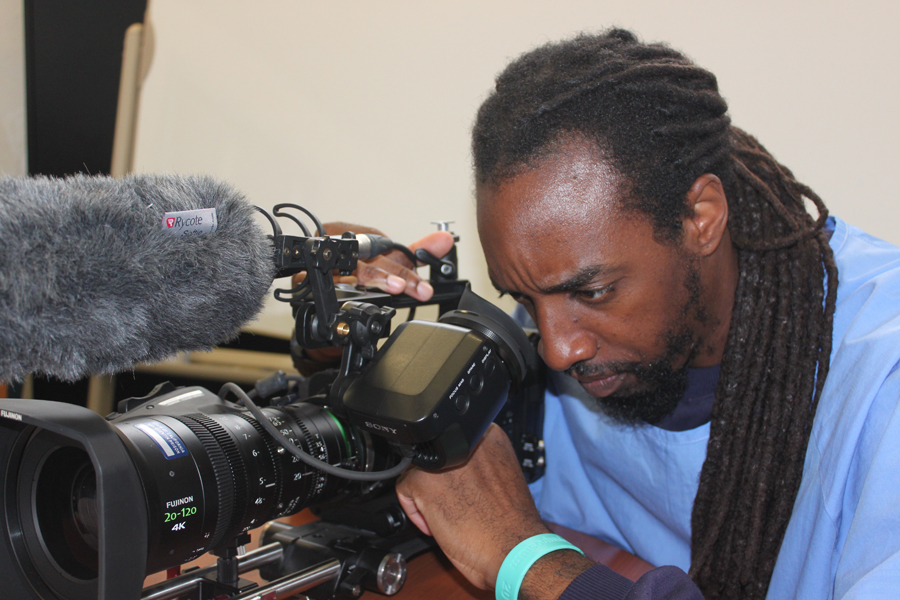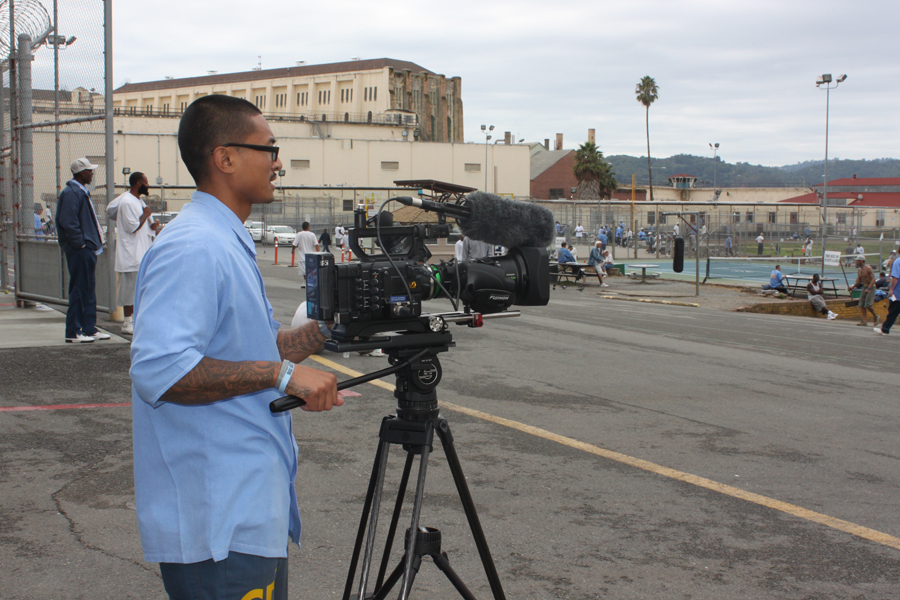SAN QUENTIN, Calif. — Against a vista of rolling hills and palm trees, a five-man film crew is setting up for a shoot. They white balance the cameras, adjust the tripods, play with composition. One man roams among them with a smaller camera, getting coverage of the shoot.
That’s not the only kind of coverage they need, though: Lt. Sam Robinson of the California Department of Corrections and Rehabilitation (CDCR) watches over them, because they must be under the supervision (the men call this “coverage”) of a corrections officer at all times. The men, members of a filmmaking program called FirstWatch, are incarcerated at San Quentin State Prison.
Artmaking programs for incarcerated people have been around for decades. California’s Arts in Corrections program, for example, began in the 1970s and — having weathered budget cutbacks in the early 2000s — currently has a presence at every CDCR facility. San Quentin itself has offered a filmmaking program before, which was the subject of a 2009 Discovery Channel series titled “San Quentin Film School.”
FirstWatch began in January 2017. Participants report to the media lab each weekday morning and spend the day working on projects until midafternoon. Two of them, Lawrence Pela, 35, and Adnan Khan, 34, have been with FirstWatch from the start. Pela has served 11 years of a 46-year sentence, and Khan has served more than 15 of a 25 year-to-life sentence. Khan co-founded FirstWatch and, in October 2017, co-founded the Oakland, Calif.-based nonprofit Re:store Justice with executive director Alex Mallick.
(Khan was freed today at a resentencing hearing, according to Mallick, after his sentence was commuted by then-Gov. Jerry Brown on Dec. 12 to 15 years to life.)

Lawrence Pela prepares a camera for a shoot.
‘Willing to be vulnerable’
“Film [is] what’s out there right now,” Khan pointed out. “When it comes to incarcerated people and how incarceration is perceived … the source of information that most people get is from the news, the movies, from YouTube or whatever else is out there about us. So having this opportunity to create our own media, we want to reclaim that narrative.”
In contrast to those stories that highlight violence and racial tension in prisons, “We sit in conversations together about our lives, the things that we’ve done and how we should change,” Pela said. “We put ourselves in places where we’re willing to be vulnerable with each other, and that’s one thing you certainly don’t see in prison movies and shows. That happens so much here.”
Most of the films focus on one element of one man’s story: “Lumumba’s Prison Journey,” “Jeff’s Garden,” “Upu’s Story.” One of their most recent, and strongest, films is about San Quentin inmate Ralph Brown, who speaks about the pain of being an incarcerated father and missing huge parts of his son’s life.
The films run just a few minutes long, and the crew’s filmmaking skills undergo a striking evolution over time. The composition, editing and sound design get tighter and more professional with each video posted on their site. The FirstWatch crew is self-taught, relying on a library of film school classics like “Bare Bones Camera Course for Film and Video” by Tom Schroeppel and “In the Blink of An Eye” by Walter Murch to guide them.
“We don’t have internet, we don’t have YouTube, and we don’t have a professional coming in here and teaching us,” Khan pointed out. “A lot of how I learn is just watching TV, watching movies and watching documentaries, literally counting how long each clip lasts.”

Kevin Neang sets up to shoot in the San Quentin yard.
The accountability message
One film, “Accountability: Choy,” shows a man dramatically backlit, seated in a chair. Punctuated by long cuts to black, Choy tells the story of Doug, a man he killed, through the points of view of Doug’s family members. Watching it is something like participating in a virtual restorative justice circle, in which victims, offenders, families and other affected community members come together to discuss a crime and its aftermath.
“Restorative justice and FirstWatch are hand in hand,” Khan said. “Accountability is a huge piece when you come to these circle settings. So what we’re trying to do is fill that [public information] gap with these videos and show we are responsible, we’re not denying our crimes, we’re not denying our actions, we’re not blaming people. We are understanding what we did and why we did it.”
In addition to posting their work online, the FirstWatch crew is planning to work with CDCR’s Office of Victim Services to promote the accountability message through video. Mike Young, the manager of Victim Services, hopes to show FirstWatch’s videos about accountability to inmates at CDCR’s 34 other facilities and to hire the crew to film inmates reading apology letters to their victims, an effort to share San Quentin’s wealth of programming with prisoners who don’t have access to such opportunities.
Victim Services hasn’t collaborated in this way with an adult inmate program, Young said. “This is one of the first times we’ve worked directly with a group of offenders, with the offenders being able to have a direct impact on the healing of the survivors.”
The benefits of formal, structured arts-in-corrections programs are well-documented. Studies consistently show that participants have fewer disciplinary infractions in prison and are less likely to violate parole, reoffend or return to prison once released, though the size of these reductions vary by study.
A 1983 cost-benefit analysis of California’s Arts-in-Corrections program found a 75 to 80.6 percent reduction in disciplinary infractions among participants, and $228,522 ($589,171 in today’s dollars) in “measurable social benefits.”

Adnan Khan and Eric Abercrombie review footage at an editing station.
Recidivism plummets
Research in 1987 found that 74 percent of parolees who had participated in the program had a clean record one year after their release, whereas 49 percent of nonparticipant parolees had a clean record after that time. The result is heightened public safety and significant taxpayer savings.
“In all cases where it was studied, arts programs [in prisons] reduced recidivism among people who had participated in the programs versus people who had not,” said Mandy Gardner, co-author of the Prison Arts Resource Project, a comprehensive list of evidence-based studies looking at arts programs in U.S. prisons and jails. Once released, she said, participants “became not only not negative parts of the community, but positive.”
Even for those with life sentences, she saw evidence of benefits to arts programs: Fewer violent crimes behind bars make the prison environment safer for officers and other offenders. And based on the volume of evidence that found increased confidence and communications skills among arts program participants, she said, “I would surmise that a program like FirstWatch would lead to better relationships with the people who are still on the outside,” such as friends and family members.
San Quentin appears to take these benefits seriously. The prison is a hub of media-making. Its media center turns out a glossy magazine called Wall City, the San Quentin News, a closed-circuit news channel, the beloved podcast “Ear Hustle” and FirstWatch.
The decision to have this kind of programming at the prison was at first based on common sense, Robinson said. “[San Quentin Warden] Ron Davis and his predecessors saw that 90 percent of people incarcerated in California end up returning to their communities. How do you want a guy to return to the community? Do you want a guy who’s been locked away and whose only opportunity has been to hone his criminalistic skills?” he asked. “Giving a person hope and a new way of looking at things is the better course of action.”
With time, he said, the numbers bore out these common-sense ideas: Participants in San Quentin programs like the Prison University Project and Guiding Rage Into Power showed huge decreases in recidivism (Guiding Rage Into Power claims a recidivism rate of 0 percent, contrasted with a statewide rate of 66.7 percent rearrested within three years). On a national scale, a 2014 RAND report found that inmates who participate in education programs have a 43 percent lower likelihood of repeat offenses and that every dollar invested in inmate education saves $5 on reincarceration costs over three years.
Mallick plans to create a similar program at the California Institution for Women, roughly 50 miles east of Los Angeles, with the hope that LA’s nearby film community will provide equipment and expertise to the women there.
But replicating San Quentin’s level of programming, particularly arts programming, at other facilities would be tough. The prison is in affluent Marin County, just outside San Francisco, with all its attendant wealth and resources — FirstWatch itself was funded with a single gift to Re:store Justice from an anonymous donor, along with in-kind donations of software, computers, and other film equipment. The Bay Area is a hotbed of criminal justice reform activity, so activists and nonprofit employees can easily commute to teach classes.
And, as the FirstWatch crew emphasized, the climate in San Quentin allows for education and self-reflection. “We’re in a very unique place in San Quentin,” said Travis Westly, 36, one of the newer members of FirstWatch. “Because of our environment, we can let our guard down. In another institution, I may have been associated with [the other men in FirstWatch], but we definitely wouldn’t have been friends. When you put people in an institution where you provide hope, you give them the ability to change themselves … I think it’s important for us to identify that change is possible. And if you give someone the opportunity to change, you never know what those results may be.”
A version of this story also appears in The Christian Science Monitor.
(This story has been updated.)

I believe this is a truly great opportunity for the inmate’s considering I was a victim of a violent crime and my rapist got off scott free I still believe it is a good thing. Also, my ex husband was in San Quentin.
Pingback: What really happens behind bars? Insiders make videos to show you. – Buzz World